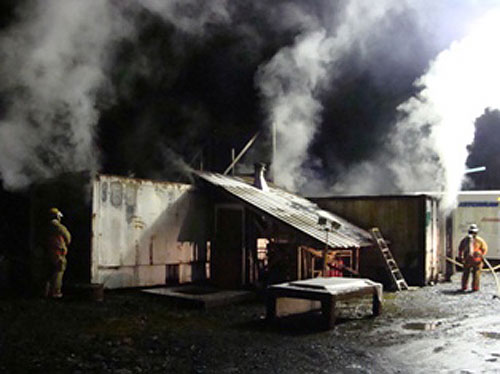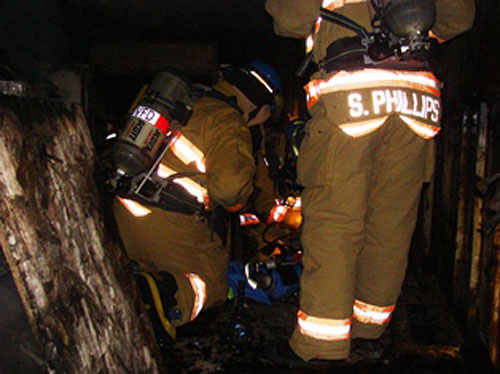 Preparing for a Firefighter's
Nightmare
Preparing for a Firefighter's
Nightmare
By DAVID HULL
February 10, 2010
Wednesday
Ketchikan, Alaska - It is every Fire Chief's nightmare, a lost
firefighter, trapped in a burning building and running out of
air. On Tuesday night, February 9, 2010 the members of North
Tongass Volunteer Fire Department (NTVFD) practiced procedures
designed to find and rescue a trapped firefighter without injuring
anyone else. A typical fire scenario was set up to test new firefighters
on their ability to get water to the fire and safely extinguish
it before backing out of the smoky 'structure.'
 The scene of the 'fire',
cargo containers configured in such a way to allow firefighters
to practice skills learned in previous drills.
The scene of the 'fire',
cargo containers configured in such a way to allow firefighters
to practice skills learned in previous drills.
Photo by David Hull
The scenario of the drill: Just when everything seems to be going
fine a firefighter goes missing. A quick check of the accountability
board and those outside of the building identifies the missing
firefighter, Captain Jerry Kiffer. Now the hard part starts.
Where is he and how do we get him out?
Through practiced search procedures,
Captain Kiffer is quickly found stuck in an old portion of the
exhaust system of the fire room. The Rapid Intervention Crew,
or RIC, is quickly called to action. The RIC pack is quickly
called for that contains life saving air and other tools designed
to free the trapped firefighter. Once the amount of air the trapped
firefighter has left was established, it was decided to attach
the firefighter to a new source of air and remove his airpack
to help with the rescue situation. Without the extra weight and
bulk the airpack adds the rescue went smoothly and Captain Kiffer
was quickly brought out of the potentially life threatening situation.
 In the drill: FF Dave
Andrews and Lt. Steve Phillips are readying the RIC pack to supply
air to Captain Kiffer, 'trapped' in an exhaust pipe in front
of them.
In the drill: FF Dave
Andrews and Lt. Steve Phillips are readying the RIC pack to supply
air to Captain Kiffer, 'trapped' in an exhaust pipe in front
of them.
Photo by David Hull
In all cases of heavy physical work done by the fire department
personnel, a rest period is ordered by the Incident Commander
to allow the personnel to rest and be checked by members of the
REHAB unit. Here the firefighters have their pulse, blood pressure
and blood oxygen levels checked and are given fluids to replace
fluid loss in the form of sweat during the operation. REHAB is
a mandated and vital process of ensuring that the FD personnel
are ready to return to duty to continue with the extinguishment
operations or to begin the process of overhaul and cleanup. Those
with elevated pulses or blood pressures are kept in REHAB until
their levels reach and acceptable lever. During this time it
is the REHAB leader that has command over the personnel and they
do not return to duty until the REHAB leader releases them.
This drill was a success, though
with any luck and a lot of practice we will never have to use
the skills learned this Tuesday night.
If this looks like something
you might want to do, please consider joining the North Tongass
Volunteer Fire Department. Call 22806710 or stop by at 13110
North Tongass Highway.
The writer David Hull
is the Fire Chief of North Tongass Volunteer Fire Department.
E-mail your news &
photos to editor@sitnews.us
Publish A Letter in SitNews Read Letters/Opinions
Contact the Editor
SitNews
©2010
Stories In The News
Ketchikan, Alaska
|


